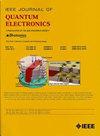High-Power Multi-Wavelength Laser Array With Uniform Spacing Based on Asymmetric Equivalent π Phase Shift
IF 2.1
3区 工程技术
Q3 ENGINEERING, ELECTRICAL & ELECTRONIC
引用次数: 0
Abstract
We experimentally demonstrated a high-power 16-wavelength DFB laser array with 1.6 nm (200 GHz) channel spacing based on the asymmetric equivalent基于非对称等效π相移的均匀间距高功率多波长激光阵列
基于非对称等效$\pi $相移($\pi $ -EPS),实验证明了具有1.6 nm (200 GHz)通道间距的高功率16波长DFB激光阵列。$\pi $ -EPS位于激光腔长度的1/5处,靠近具有高反射(HR)涂层的facet,提高了单纵向模式(SLM)操作的产量。在偏置电流为250 mA时,测量到的通道间距为1.6 nm ~0.1 nm。该阵列在400毫安时每个通道的输出功率超过120毫瓦。实现了SLM性能,在室温下侧模抑制比(SMSRs)大于50 dB。此外,在70 mA偏置电流下,相对强度噪声(RIN)保持在-160 dB/Hz以下。这些结果表明,这种激光阵列具有大规模硅光子学应用的巨大潜力。因此,所提出的激光阵列将有利于大规模硅光子学的应用。
本文章由计算机程序翻译,如有差异,请以英文原文为准。
求助全文
约1分钟内获得全文
求助全文
来源期刊

IEEE Journal of Quantum Electronics
工程技术-工程:电子与电气
CiteScore
4.70
自引率
4.00%
发文量
99
审稿时长
3.0 months
期刊介绍:
The IEEE Journal of Quantum Electronics is dedicated to the publication of manuscripts reporting novel experimental or theoretical results in the broad field of the science and technology of quantum electronics. The Journal comprises original contributions, both regular papers and letters, describing significant advances in the understanding of quantum electronics phenomena or the demonstration of new devices, systems, or applications. Manuscripts reporting new developments in systems and applications must emphasize quantum electronics principles or devices. The scope of JQE encompasses the generation, propagation, detection, and application of coherent electromagnetic radiation having wavelengths below one millimeter (i.e., in the submillimeter, infrared, visible, ultraviolet, etc., regions). Whether the focus of a manuscript is a quantum-electronic device or phenomenon, the critical factor in the editorial review of a manuscript is the potential impact of the results presented on continuing research in the field or on advancing the technological base of quantum electronics.
 求助内容:
求助内容: 应助结果提醒方式:
应助结果提醒方式:


